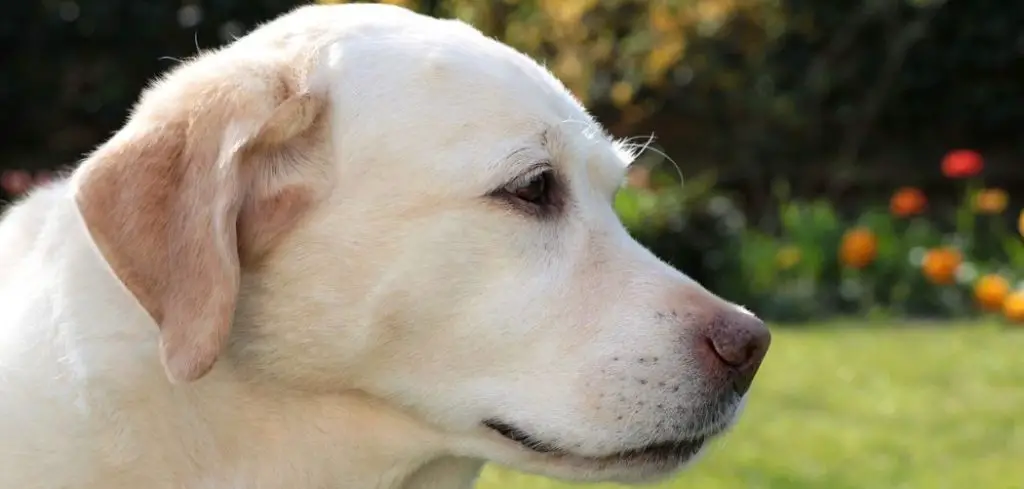Hair loss in old dogs can be alarming for owners, as it may indicate underlying health issues or natural aging changes.
While some shedding is normal, sudden or excessive hair loss often signals a medical or environmental concern.
We outline the common causes of hair loss in old dogs, what you can do at home, and when to seek veterinary help.
Old Dog Losing Hair — Why It Happens
Hair loss in old dogs can happen for several reasons. Common causes include allergies (to food, fleas, or the environment), hormonal problems like hypothyroidism or Cushing’s disease, skin infections, or parasites such as mites. Stress, poor nutrition, and even natural aging can also make a dog’s coat thinner.

Old Dog Losing Hair: Common Causes
Hormonal Imbalances
Hormonal changes are a frequent culprit behind hair loss in senior dogs. Conditions such as hypothyroidism, where the thyroid gland does not produce enough hormones, can lead to thinning coats, dry skin, and slower hair regrowth.
Signs to watch for include lethargy, weight gain, and dull or brittle hair. Hormonal issues are particularly concerning because untreated conditions can affect multiple body systems, impacting your dog’s metabolism, heart function, and energy levels.
Read more: Old Dog Losing Hair in Patches and Scabs (Common causes and solutions)
Cushing’s Disease
Cushing’s disease occurs when the adrenal glands produce excessive cortisol, a stress hormone.
This imbalance often leads to symmetrical hair loss on the body, skin darkening, and a pot-bellied appearance.
Dogs may also develop increased thirst and urination. If left untreated, Cushing’s disease can contribute to diabetes, infections, and other severe health problems, making early veterinary diagnosis critical.
Skin Infections and Parasites
Bacterial, fungal, or parasitic infections, including mange mites and fleas, can cause patchy hair loss and inflamed skin.
Affected areas may appear red, scaly, or itchy, and dogs might scratch, lick, or chew at the spots frequently.
Skin infections are serious because they can quickly worsen and lead to secondary infections or systemic illness if not treated promptly.
Nutritional Deficiencies
Poor nutrition or age-related dietary needs can contribute to hair thinning and coat deterioration.
Proteins, essential fatty acids, and vitamins like zinc and biotin are critical for maintaining healthy skin and fur.
Signs of deficiency include dull, brittle hair, slow regrowth, and overall coat thinning. Providing a high-quality, senior-appropriate diet or supplements (as advised by your vet) can significantly improve coat health over time.
Allergies
Allergies, whether environmental, food-based, or contact-related, can trigger hair loss in older dogs.
Symptoms often include persistent itching, redness, and hair thinning, typically around the face, paws, or belly.
Allergies can be serious if left unmanaged, as continual scratching and skin irritation may result in infections and chronic discomfort for your dog.
Stress and Behavioral Causes
Behavioral factors, such as excessive licking or chewing due to anxiety or boredom, can also lead to localized hair loss.
Senior dogs may become stressed by changes in their environment, routine, or health status.
Over time, compulsive behaviors can damage the skin, create bald patches, and predispose the dog to secondary infections.
What to Do If Your Old Dog Is Losing Hair
Start by observing your dog’s overall health and coat condition. Regularly brushing your dog can help remove loose hair and identify early patches of hair loss.
Ensure your dog receives a balanced, senior-appropriate diet rich in protein, omega-3 fatty acids, and essential vitamins. These nutrients support hair regrowth and skin health.
Maintain good parasite control with regular flea, tick, and mite treatments recommended by your veterinarian.
Minimize stress by keeping a consistent routine, providing interactive toys, and giving your dog safe spaces for rest and comfort.
Monitor for signs of infection, irritation, or rapid hair loss, and take photos to track changes over time. Sharing these observations with your vet can help pinpoint the underlying cause quickly.
When to Call or Visit Your Vet
Seek veterinary attention immediately if your dog experiences sudden, severe hair loss, widespread bald patches, or signs of infection like redness, swelling, or discharge.
Persistent scratching, licking, or chewing that damages the skin should prompt a vet visit to rule out parasites, allergies, or underlying medical conditions.
Hair loss accompanied by lethargy, weight changes, excessive thirst, or appetite loss requires prompt evaluation, as these could indicate hormonal or systemic disease.
Early intervention improves outcomes, prevents secondary complications, and helps your senior dog maintain comfort and a healthy coat.
Read more: Old Dog Losing Weight (What to do and when to worry)
Key Takeaway
Hair loss in old dogs can stem from various causes, including hormonal imbalances, infections, nutritional deficiencies, allergies, and behavioral issues.
While some shedding is natural, noticeable or sudden hair loss deserves attention. Observing your dog’s coat, maintaining proper nutrition, reducing stress, and seeking veterinary care when necessary are essential steps.
Early identification and treatment can improve your dog’s comfort, coat health, and overall quality of life, keeping your senior companion happy and healthy.
